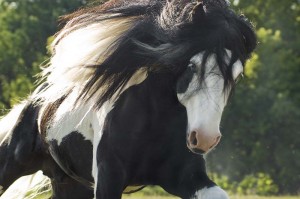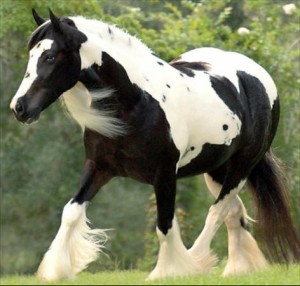Horse Breeds – The Gypsy Vanner Horse Breed
December is Breed month and we will be featuring breeds on the Thistle Ridge Stables blog/website. If you have a breed to feature we would love to hear from you!.
I recently had the opportunity to work with a Gypsy Vanner Horse. Coming from a background of non-draft breeds I was

quite taken aback with their pleasant demeaner and their feathers… on their hocks!
Brief History
This small draft horse, the one I rode is around 14.2hh, traces its roots to the Romanys, who had no need for the larger drafts. For almost 100 years the Romany people, or Gypsies, have bred the cob to pull their traditional carts and “mobile homes” throughout the country lanes of Ireland and England. And although many of the “Travelers” – as the ones who move about the country are called – have changed to more modern conveyances, there are still those who cling to the traditional mode of travel.
Even though many people of the Romany heritage no longer travel, they continue to breed these colorful horses as a way of keeping tradition alive. As long ago the modern Gypsy’s wealth is still, in a large part, measured by the size and quality of his horse herd.
Description and Conformation
The Gypsy Cob has no one specific color. The most common are pinto patterned, piebald, and skewbald. They are small, in that they traditionally stand 13 to 15.2 hands (52 to 60.8 in., or 132 to 154 cm.) at the shoulder. They are compact, yet sturdy and durable. Their stamina allows them to pull a loaded “living wagon”, at a steady trot, all day long.

In order to be classified as a traditional Gypsy horse, they must have an abundance of hair and feathering. The feathering starts at the knee and grows all over the bottom half of the leg to the hoof.
The Gypsy Cob has been bred for a particular type for years, but can trace their ancestral roots back to Clydesdales, Shires, Friesians, and Irish Drafts as well a Connemara, Dales, and Fell ponies. This horse is typically known to be very sound and sane, a faithful companion, and to possess incredible versatility.
The first registered horses were imported to North America in November 1996. There are three different registry classifications for the breed in the US, based on height. If the horse is under 14 hands (56 inches, 142 cm), it is considered to be a “mini Gypsy”. If the horse is 14-15.2 hands high, it is known as a “classic Gypsy”, and if the breed is 15.2 or taller, it is known as a “grand Gypsy”.[3] In 2004, the breed became recognized by the United States Dressage Federation All Breeds Program, and can win breed-specific awards whenever it wins a dressage event or any event sponsored by the USDF.[2]

 Try these three powerful exercises to get strengthen your position.
Try these three powerful exercises to get strengthen your position.

They are beautiful and of course I love the pinto coloring. 🙂 I also love the fact that some of them are pony size. A friend of mine that is in our club raises Gypsy’s and I need to make a point to go and visit her farm. Great post!